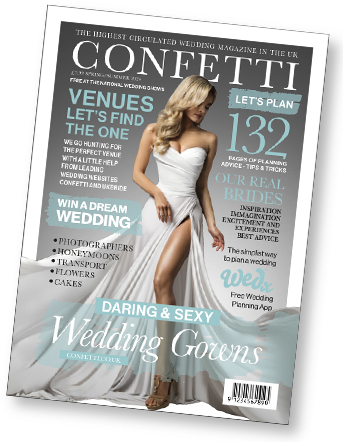If you’re handy with a sewing machine and want to create a wedding dress that is truly unique here’s what to consider when it comes to making your own low-cost, big ‘wow factor’ gown. And once you’ve made your dress, you’ll want to make your bridesmaids dresses too.

Dressmaking basics
Whether you are making your own dress or using a dressmaker, make sure you choose the style and fabric of the dress at least six months before the wedding. This allows plenty of time for fittings and alterations. The first fitting is generally eight weeks before the wedding, with as many subsequent fittings as are necessary to ensure a perfect fit.
If a dressmaker is making their gowns, the bridesmaids should be measured by her. If they live out of town, have them professionally measured and send the details to the dressmaker. Ideally, all the bridesmaids should have a fitting at least a month before the wedding, so any necessary adjustments can be made. Shoe styles need not be identical, but if the bridesmaids’ shoes are being dyed make sure they are all done in one batch in case the tone of the dye varies.
Cost control
Choosing cheaper fabrics is one way of keeping costs down. Synthetic satin will always be cheaper than a silk satin, for example, while dupion costs less than duchesse satin. If money is really tight, choose dresses with a slender silhouette for your and your maids, as they require less fabric.
Can’t find exactly what you’re looking for when it comes to your dress? Seen the dress of your dreams ‐‐ only to find it’s out of your price range? Decided on a bevy of bridesmaids, only to discover that off‐the‐peg dresses aren’t in the right tones for your colour theme?
At times like these, many brides decide to ask a dressmaker to create dresses for them or their bridesmaids. Alternatively, if you or your mum is a dab hand with a needle and thread, you might well be tempted to make your own gowns.

Material matters
The style and fabric you choose will depend on the type of wedding you’re planning. A formal wedding might call for a full‐skirted, floor‐length duchesse satin gown, complete with train and veil. However, for a less formal affair, you could opt for a slinky bias‐cut crepe number with a flirtatious feathery headdress.
It’s also important to bear in mind where your wedding will take place. If you’re getting married on a tropical beach, there’s no point in hankering after a heavy brocade Victorian‐style gown with corset and flowing train. Instead you’d be better advised to choose a floaty chiffon dress suitable for a hot climate.
If you’re planning to have a theme to your wedding, it can be reflected in your dress. A wedding at a medieval stately home might inspire a Tudor‐style gown in devoré or crepe and bridesmaids in rich jewel colours, while a silver satin gown in a simple, sleek style would be perfect for a contemporary celebration with a dramatic metallic theme.
Take your size and shape into account too. A full‐skirted dress suits anyone tending to the top‐heavy, as the full skirt gives the gown balance. Slinky bias‐cut numbers favour those with a boyish figure. Princess‐line gowns are ideal for the English pear‐shape as they camouflage heavy hips and large bottoms. And the Empire line is perfect if you are petite.
Bridesmaids dresses
Dressing several bridesmaids who are different ages, shapes and sizes can be a challenge. Consider whether you want them all to wear the same dress in the same colour. If your bridesmaids have very different figures and complexions, what suits one might look less than flattering on another.
One solution is to pick a fabric in your wedding colour theme, then choose a slightly different style for each maid. Your pregnant sister will look good in an Empire‐line gown with cap sleeves, while your slim best friend can sport something more sexy and strappy. Different dresses can be unified by matching accessories ‐‐ why not make all the bridesmaids a matching wrap in organza or chiffon?
If you want all your bridesmaids to wear the same outfit, start by looking for a dress that suits the one with the most difficult figure. Chances are it will also look good on those with more regular shapes. If your bridesmaids are different ages, you could make the older bridesmaids’ outfits in darker shades and younger bridesmaids’ dresses in a lighter shade of the same colour. Alternatively, buy younger bridesmaids party dresses from a high‐street store, then make them sashes in the same colour and fabric as the older bridesmaids’ dresses.
View our recommended UK retailers and stockists for wedding dresses

